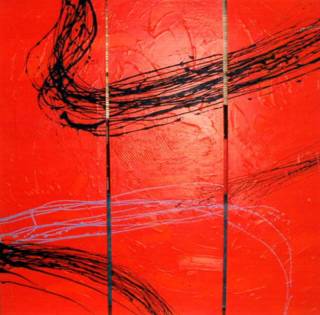 Filmmaker Elwood Perez, the most rumored movie actress Maui Taylor and Me in “Private Parts?
Filmmaker Elwood Perez, the most rumored movie actress Maui Taylor and Me in “Private Parts?Well, not really but it was my controversial painting “Menstrual Period in Political History”, which will be used as part of the play at the Music Museum in Greenhills on November 30 – December 1, 2005.
I thought, after a brief hiatus from the controversy in Philippine art scene, one of the contentious pieces that I exhibited early this year will be laid to rest forever in anonymity. Until a week ago, my good friend, a legendary and multi-awarded movie director, Elwood Perez, called me on the phone that he is going to use the artwork as icon of private parts, literally and figuratively, in his theatrical show titled “Private Parts”.
Director Elwood Perez, Myself & Paula Brillson.
 At first I was hesitant to say yes, but later I realized that it was him and another friend Paula Brillson, a lawyer and media consultant from New York, who fought and stood by me at the height of my controversial one-man show at The Podium last July 2005. For one thing, it was too offensive, according to the mall manager, to the sensitivity of the Filipinos because of the outright portrayal of vaginal form. Second, it was a provocative artwork criticizing the political leadership of a female President of the country.
At first I was hesitant to say yes, but later I realized that it was him and another friend Paula Brillson, a lawyer and media consultant from New York, who fought and stood by me at the height of my controversial one-man show at The Podium last July 2005. For one thing, it was too offensive, according to the mall manager, to the sensitivity of the Filipinos because of the outright portrayal of vaginal form. Second, it was a provocative artwork criticizing the political leadership of a female President of the country.Me & the former Pres. Corazon Aquino in 1996.
 It was also during the time of my exhibition that the former female president, Madam Corazon C. Aquino, went out from the comfort of her shell and led a massive rally at the Ayala Avenue in Makati protesting the present Madam President, Gloria Macapagal-Arroyo, to resign from her post because of allegedly electoral fraud that won her presidency with its infamous nickname “Hello Garci”.
It was also during the time of my exhibition that the former female president, Madam Corazon C. Aquino, went out from the comfort of her shell and led a massive rally at the Ayala Avenue in Makati protesting the present Madam President, Gloria Macapagal-Arroyo, to resign from her post because of allegedly electoral fraud that won her presidency with its infamous nickname “Hello Garci”.Because of the irrational uproar on the vaginal form and the political content of my artwork, the rally of Madam Cory and the “Hello Garci” hullabaloo, my two prospective collectors, a Belgian and a Filipino-Chinese who were vying to own the “Menstrual Period in Political History”, withdrew from the reservation list because they don’t want their names to be dragged into the controversy.
"The menstrual Period in Political History", mixed media on metamorphic rock (left), "The Cocoon of Life",oil on paper (center), and the "Poetry of Nails & Blood", acrylic and nails on metamorphic rock and board.
Fashion Model Avi Siwa
 Meanwhile, visiting the rehearsal of “Private Parts” at the Viva Productions studio was exciting because I met another legendary and veteran movie director Behn Cervantes and, of course, Maui Taylor, and other casts of the play.
Meanwhile, visiting the rehearsal of “Private Parts” at the Viva Productions studio was exciting because I met another legendary and veteran movie director Behn Cervantes and, of course, Maui Taylor, and other casts of the play.Talking of Maui Taylor, she is a very lovely cuddly petite young woman whose angelic face could be mistaken as an innocent girl next door. She is not a prima donna type of actress but down to earth, soft spoken, intelligent with mesmerizing presence.
Actor-producer Allen Dizon
 In the middle of our conversation about art and philosophy, which eventually led her plan to purchase one of my works the “Poetry of Nails and Blood” for her condominium unit, Maui asked me to join her lunch at 5 p.m. (?) while other casts were still rehearsing. She was so hungry that she finished two meal-packs of scrumptious spaghetti served by Dennis Evangelista, the manager of movie actor Allen Dizon.
In the middle of our conversation about art and philosophy, which eventually led her plan to purchase one of my works the “Poetry of Nails and Blood” for her condominium unit, Maui asked me to join her lunch at 5 p.m. (?) while other casts were still rehearsing. She was so hungry that she finished two meal-packs of scrumptious spaghetti served by Dennis Evangelista, the manager of movie actor Allen Dizon.The “Private Parts”, written by another friend screenplay writer Jigz Recto, is a satirical take on the politics in show business and the dying "sexy movie" industry in Philippine cinema. The play is produced by actor Allen Dizon and his manager Dennis Evangelista; music by Jobin Ballesteros and choreographed by Bong Embile.
Fashion model/movie actress Wilma Doesn't.
 The casts are director Behn Cervantes, the controversial movie actress who had been linked to the presidential son, Maui Taylor, actor and producer of the show Allen Dizon, Wilma Doesn't, Myles Hernandez, Ynez Veneracion, Avi Siwa, Vangie Labalan and Margie Sofia Rei under the direction of Director Elwood Perez and assistant dierctor Armando Reyes.
The casts are director Behn Cervantes, the controversial movie actress who had been linked to the presidential son, Maui Taylor, actor and producer of the show Allen Dizon, Wilma Doesn't, Myles Hernandez, Ynez Veneracion, Avi Siwa, Vangie Labalan and Margie Sofia Rei under the direction of Director Elwood Perez and assistant dierctor Armando Reyes.The “Private Parts” will be shown on November 30 – December 1, 2005 at the Music Museum in Greenhills, Quezon City.








